From Wikipedia, the free encyclopedia
This is one of a collection of articles which has a direct, or indirect relevance for the development of the UDP. Blogger Ref http://www.p2pfoundation.net/Universal_Debating_Project
This is one of a collection of articles which has a direct, or indirect relevance for the development of the UDP. Blogger Ref http://www.p2pfoundation.net/Universal_Debating_Project
For other uses, see Education (disambiguation).

School children sitting in the shade of an orchard in Bamozai, near Gardez, Paktya Province, Afghanistan
Education is commonly and formally divided into stages such as preschool, primary school, secondary school and then college, university or apprenticeship. The methodology of teaching is called pedagogy.
A right to education has been recognized by some governments. At the global level, Article 13 of the United Nations' 1966 International Covenant on Economic, Social and Cultural Rights recognizes the right of everyone to an education.[2] Although education is compulsory in most places up to a certain age, attendance at school often isn't, and a minority of parents choose home-schooling, sometimes with the assistance of modern electronic educational technology (also called e-learning). Education can take place in formal or informal settings.
Contents
[hide]Etymology[edit]
Etymologically, the word "education" is derived from the Latin ēducātiō ("A breeding, a bringing up, a rearing") from ēdūcō ("I educate, I train") which is related to the homonym ēdūcō ("I lead forth, I take out; I raise up, I erect") from ē- ("from, out of") and dūcō ("I lead, I conduct").[3]History[edit]
Main article: History of education

Matteo Ricci (left) and Xu Guangqi (right) in the Chinese edition of Euclid's Elements published in 1607
In China, Confucius (551-479 BCE), of the State of Lu, was the country's most influential ancient philosopher, whose educational outlook continues to influence the societies of China and neighbors like Korea, Japan and Vietnam. Confucius gathered disciples and searched in vain for a ruler who would adopt his ideals for good governance, but his Analects were written down by followers and have continued to influence education in East Asia into the modern era.[citation needed]
After the Fall of Rome, the Catholic Church became the sole preserver of literate scholarship in Western Europe. The church established cathedral schools in the Early Middle Ages as centers of advanced education. Some of these establishments ultimately evolved into medieval universities and forebears of many of Europe's modern universities.[6] During the High Middle Ages, Chartres Cathedral operated the famous and influential Chartres Cathedral School. The medieval universities of Western Christendom were well-integrated across all of Western Europe, encouraged freedom of inquiry, and produced a great variety of fine scholars and natural philosophers, including Thomas Aquinas of the University of Naples, Robert Grosseteste of the University of Oxford, an early expositor of a systematic method of scientific experimentation,[7] and Saint Albert the Great, a pioneer of biological field research.[8] The University of Bologne is considered the oldest continually operating university.
Elsewhere during the Middle Ages, Islamic science and mathematics flourished under the Islamic caliphate which was established across the Middle East, extending from the Iberian Peninsula in the west to the Indus in the east and to the Almoravid Dynasty and Mali Empire in the south.
The Renaissance in Europe ushered in a new age of scientific and intellectual inquiry and appreciation of ancient Greek and Roman civilizations. Around 1450, Johannes Gutenberg developed a printing press, which allowed works of literature to spread more quickly. The European Age of Empires saw European ideas of education in philosophy, religion, arts and sciences spread out across the globe. Missionaries and scholars also brought back new ideas from other civilisations — as with the Jesuit China missions who played a significant role in the transmission of knowledge, science, and culture between China and Europe, translating works from Europe like Euclid's Elements for Chinese scholars and the thoughts of Confucius for European audiences. The Enlightenment saw the emergence of a more secular educational outlook in Europe.
In most countries today, full-time education, whether at school or otherwise, is compulsory for all children up to a certain age. Due to this the proliferation of compulsory education, combined with population growth, UNESCO has calculated that in the next 30 years more people will receive formal education than in all of human history thus far.[9]
Formal education[edit]
Formal education occurs in a structured environment whose explicit purpose is teaching students. Usually, formal education takes place in a school environment with classrooms of multiple students learning together with a trained, certified teacher of the subject. Most school systems are designed around a set of values or ideals that govern all educational choices in that system. Such choices include curriculum, physical classroom design, student-teacher interactions, methods of assessment, class size, educational activities, and more.[10][11]Preschool[edit]
Main article: Early childhood education
Preschools provide education from ages approximately three to seven, depending on the country, when children enter primary education. These are also known as nursery schools and as kindergarten, except in the USA, where kindergarten is a term used for primary education. Kindergarten "provide[s] a child-centered, preschool curriculum for three- to seven-year-old children that aim[s] at unfolding the child's physical, intellectual, and moral nature with balanced emphasis on each of them."[12]Primary[edit]
Main article: Primary education
Primary (or elementary) education consists of the first five to seven years of formal, structured education. In general, primary education consists of six to eight years of schooling starting at the age of five or six, although this varies between, and sometimes within, countries. Globally, around 89% of children aged six to twelve are enrolled in primary education, and this proportion is rising.[13] Under the Education For All programs driven by UNESCO, most countries have committed to achieving universal enrollment in primary education by 2015, and in many countries, it is compulsory. The division between primary and secondary education is somewhat arbitrary, but it generally occurs at about eleven or twelve years of age. Some education systems have separate middle schools, with the transition to the final stage of secondary education taking place at around the age of fourteen. Schools that provide primary education, are mostly referred to as primary schools or elementary schools. Primary schools are often subdivided into infant schools and junior school.In India, for example, compulsory education spans over twelve years, with eight years of elementary education, five years of primary schooling and three years of upper primary schooling. Various states in the republic of India provide 12 years of compulsory school education based on a national curriculum framework designed by the National Council of Educational Research and Training.
Secondary[edit]
Main article: Secondary education
In most contemporary educational systems of the world, secondary education comprises the formal education that occurs during adolescence. It is characterized by transition from the typically compulsory, comprehensive primary education for minors, to the optional, selective tertiary, "postsecondary", or "higher" education (e.g. university, vocational school) for adults. Depending on the system, schools for this period, or a part of it, may be called secondary or high schools, gymnasiums, lyceums, middle schools, colleges, or vocational schools. The exact meaning of any of these terms varies from one system to another. The exact boundary between primary and secondary education also varies from country to country and even within them, but is generally around the seventh to the tenth year of schooling. Secondary education occurs mainly during the teenage years. In the United States, Canada and Australia, primary and secondary education together are sometimes referred to as K-12 education, and in New Zealand Year 1–13 is used. The purpose of secondary education can be to give common knowledge, to prepare for higher education, or to train directly in a profession.Secondary education in the United States did not emerge until 1910, with the rise of large corporations and advancing technological in factories, which required skilled workers. In order to meet this new job demand, high schools were created, with a curriculum focused on practical job skills that would better prepare students for white collar or skilled blue collar work. This proved beneficial for both employers and employees, since the improved human capital lowered costs for the employer, while skilled employees received a higher wages.
Secondary education has a longer history in Europe, where grammar schools or academies date from as early as the 16th century, in the form of public schools, fee-paying schools, or charitable educational foundations, which themselves date even further back.
Community colleges offer another option at this transitional stage of education. They provide nonresidential junior college courses to people living in a particular area.
Tertiary (higher)[edit]
See also: Higher education and Adult education
Higher education, also called tertiary, third stage, or postsecondary education, is the non-compulsory educational level that follows the completion of a school such as a high school or secondary school. Tertiary education is normally taken to include undergraduate and postgraduate education, as well as vocational education and training. Colleges and universities mainly provide tertiary education. Collectively, these are sometimes known as tertiary institutions. Individuals who complete tertiary education generally receive certificates, diplomas, or academic degrees.Higher education typically involves work towards a degree-level or foundation degree qualification. In most developed countries a high proportion of the population (up to 50%) now enter higher education at some time in their lives. Higher education is therefore very important to national economies, both as a significant industry in its own right, and as a source of trained and educated personnel for the rest of the economy.
University education includes teaching, research, and social services activities, and it includes both the undergraduate level (sometimes referred to as tertiary education) and the graduate (or postgraduate) level (sometimes referred to as graduate school). Universities are generally composed of several colleges. In the United States, universities can be private and independent like Yale University; public and state-governed like the Pennsylvania State System of Higher Education; or independent but state-funded like the University of Virginia. A number of career specific courses are now available to students through the Internet.
One type of university education is a liberal arts education, which can be defined as a "college or university curriculum aimed at imparting broad general knowledge and developing general intellectual capacities, in contrast to a professional, vocational, or technical curriculum."[14] Although what is known today as liberal arts education began in Europe,[15] the term "liberal arts college" is more commonly associated with institutions in the United States.[16]
Vocational[edit]
Main article: Vocational education
Vocational education is a form of education focused on direct and practical training for a specific trade or craft. Vocational education may come in the form of an apprenticeship or internship as well as institutions teaching courses such as carpentry, agriculture, engineering, medicine, architecture and the arts.Special[edit]
Main article: Special education
In the past, those who were disabled were often not eligible for public education. Children with disabilities were repeatedly denied an education by physicians or special tutors. These early physicians (people like Itard, Seguin, Howe, Gallaudet) set the foundation for special education today. They focused on individualized instruction and functional skills. In its early years, special education was only provided to people with severe disabilities, but more recently it has been opened to anyone who has experienced difficulty learning.[17]Other educational forms[edit]
Alternative[edit]
Main article: Alternative education
While considered "alternative" today, most alternative systems have existed since ancient times. After the public school system was widely developed beginning in the 19th century, some parents found reasons to be discontented with the new system. Alternative education developed in part as a reaction to perceived limitations and failings of traditional education. A broad range of educational approaches emerged, including alternative schools, self learning, homeschooling and unschooling. Example alternative schools include Montessori schools, Waldorf schools (or Steiner schools), Friends schools, Sands School, Summerhill School, The Peepal Grove School, Sudbury Valley School, Krishnamurti schools, and open classroom schools.In time, some ideas from these experiments and paradigm challenges may be adopted as the norm in education, just as Friedrich Fröbel's approach to early childhood education in 19th century Germany has been incorporated into contemporary kindergarten classrooms. Other influential writers and thinkers have included the Swiss humanitarian Johann Heinrich Pestalozzi; the American transcendentalists Amos Bronson Alcott, Ralph Waldo Emerson, and Henry David Thoreau; the founders of progressive education, John Dewey and Francis Parker; and educational pioneers such as Maria Montessori and Rudolf Steiner, and more recently John Caldwell Holt, Paul Goodman, Frederick Mayer, George Dennison and Ivan Illich.
Indigenous[edit]
Main article: Indigenous education
Indigenous education refers to the inclusion of indigenous knowledge, models, methods, and content within formal and non-formal educational systems. Often in a post-colonial context, the growing recognition and use of indigenous education methods can be a response to the erosion and loss of indigenous knowledge and language through the processes of colonialism. Furthermore, it can enable indigenous communities to "reclaim and revalue their languages and cultures, and in so doing, improve the educational success of indigenous students."[18]Informal learning[edit]
Main article: informal learning
Informal learning is one of three forms of learning defined by the Organisation for Economic Co-operation and Development (OECD). Informal learning occurs in a variety of places, such as at home, work, and through daily interactions and shared relationships among members of society. For many learners this includes language acquisition, cultural norms and manners. Informal learning for young people is an ongoing process that also occurs in a variety of places, such as out of school time, in youth programs at community centers and media labs.Informal learning usually takes place outside educational establishments, does not follow a specified curriculum and may originate accidentally, sporadically, in association with certain occasions, from changing practical requirements. It is not necessarily planned to be pedagogically conscious, systematic and according to subjects, but rather unconsciously incidental, holistically problem-related, and related to situation management and fitness for life. It is experienced directly in its "natural" function of everyday life and is often spontaneous.
The concept of 'education through recreation' was applied to childhood development in the 19th century.[19] In the early 20th century, the concept was broadened to include young adults but the emphasis was on physical activities.[20] L.P. Jacks, also an early proponent of lifelong learning, described education through recreation: "A master in the art of living draws no sharp distinction between his work and his play, his labour and his leisure, his mind and his body, his education and his recreation. He hardly knows which is which. He simply pursues his vision of excellence through whatever he is doing and leaves others to determine whether he is working or playing. To himself he always seems to be doing both. Enough for him that he does it well."[21] Education through recreation is the opportunity to learn in a seamless fashion through all of life's activities.[22] The concept has been revived by the University of Western Ontario to teach anatomy to medical students.[22]
Self-directed learning[edit]
Main article: Autodidacticism
Autodidacticism (also autodidactism) is a contemplative, absorbing process, of "learning on your own" or "by yourself", or as a self-teacher. Some autodidacts spend a great deal of time reviewing the resources of libraries and educational websites. One may become an autodidact at nearly any point in one's life. While some may have been informed in a conventional manner in a particular field, they may choose to inform themselves in other, often unrelated areas. Notable autodidacts include Abraham Lincoln (U.S. president), Srinivasa Ramanujan (mathematician), Michael Faraday (chemist and physicist), Charles Darwin (naturalist), Thomas Alva Edison (inventor), Tadao Ando (architect), George Bernard Shaw (playwright), Frank Zappa (composer, recording engineer, film director), and Leonardo da Vinci (engineer, scientist, mathematician).Open education and electronic technology[edit]
Main articles: Open education and Educational technologyIn 2012, the modern use of electronic educational technology (also called e-learning) had grown at 14 times the rate of traditional learning.[clarification needed][23] Open education is fast growing to become the dominant form of education, for many reasons such as its efficiency and results compared to traditional methods.[24] Cost of education has been an issue throughout history, and a major political issue in most countries today. Online courses often can be more expensive than face-to-face classes. Out of 182 colleges surveyed in 2009 nearly half said tuition for online courses was higher than for campus based ones.[25] Many large university institutions are now starting to offer free or almost free full courses such as Harvard, MIT and Berkeley teaming up to form edX. Other universities offering open education are Stanford, Princeton, Duke, Johns Hopkins, Edinburgh, U. Penn, U. Michigan, U. Virginia, U. Washington, and Caltech. It has been called the biggest change in the way we learn since the printing press.[26] Despite favorable studies on effectiveness, many people may still desire to choose traditional campus education for social and cultural reasons.[27]
The conventional merit-system degree is currently not as common in open education as it is in campus universities, although some open universities do already offer conventional degrees such as the Open University in the United Kingdom. Presently, many of the major open education sources offer their own form of certificate. Due to the popularity of open education, these new kind of academic certificates are gaining more respect and equal "academic value" to traditional degrees.[28] Many open universities are working to have the ability to offer students standardized testing and traditional degrees and credentials.[29] A culture is beginning to form around distance learning for people who are looking to social connections enjoyed on traditional campuses. For example, students may create study groups, meetups and movements such as UnCollege.
Development goals[edit]
Universal Primary Education is one of the eight international Millennium Development Goals, towards which progress has been made in the past decade, though barriers still remain.[30] Securing charitable funding from prospective donors is one particularly persistent problem. Researchers at the Overseas Development Institute have indicated that the main obstacles to funding for education include conflicting donor priorities, an immature aid architecture, and a lack of evidence and advocacy for the issue.[30] Additionally, Transparency International has identified corruption in the education sector as a major stumbling block to achieving Universal Primary Education in Africa.[31] Furthermore, demand in the developing world for improved educational access is not as high as foreigners have expected. Indigenous governments are reluctant to take on the ongoing costs involved. There is also economic pressure from some parents, who prefer their children to earn money in the short term rather than work towards the long-term benefits of education.[citation needed]
A study conducted by the UNESCO International Institute for Educational Planning indicates that stronger capacities in educational planning and management may have an important spill-over effect on the system as a whole.[32] Sustainable capacity development requires complex interventions at the institutional, organizational and individual levels that could be based on some foundational principles:
- national leadership and ownership should be the touchstone of any intervention;
- strategies must be context relevant and context specific;[clarification needed]
- plans should employ an integrated set of complementary interventions, though implementation may need to proceed in steps;[clarification needed]
- partners should commit to a long-term investment in capacity development, while working towards some short-term achievements;
- outside intervention should be conditional on an impact assessment of national capacities at various levels;
- a certain percentage of students should be removed for improvisation of academics (usually practiced in schools, after 10th grade).
Internationalization[edit]
Nearly every country now has Universal Primary Education.Similarities — in systems or even in ideas — that schools share internationally have led to an increase in international student exchanges. The European Socrates-Erasmus Program[33] facilitates exchanges across European universities. The Soros Foundation[34] provides many opportunities for students from central Asia and eastern Europe. Programs such as the International Baccalaureate have contributed to the internationalization of education. The global campus online, led by American universities, allows free access to class materials and lecture files recorded during the actual classes.
Education and technology in developing countries[edit]
The OLPC foundation, a group out of MIT Media Lab and supported by several major corporations, has a stated mission to develop a $100 laptop for delivering educational software. The laptops were widely available as of 2008. They are sold at cost or given away based on donations.
In Africa, the New Partnership for Africa's Development (NEPAD) has launched an "e-school program" to provide all 600,000 primary and high schools with computer equipment, learning materials and internet access within 10 years.[35] An International Development Agency project called nabuur.com,[36] started with the support of former American President Bill Clinton, uses the Internet to allow co-operation by individuals on issues of social development.
India is developing technologies that will bypass land-based telephone and Internet infrastructure to deliver distance learning directly to its students. In 2004, the Indian Space Research Organization launched EDUSAT, a communications satellite providing access to educational materials that can reach more of the country's population at a greatly reduced cost.[37]
Private vs public funding in developing countries[edit]
Research into LCPSs (low cost private schools) found that over 5 years to July 2013, debate around LCPSs to achieving Education for All (EFA) objectives was polarised and finding growing coverage in international policy.[38] The polarisation was due to disputes around whether the schools are affordable for the poor, reaching disadvantaged groups, provide quality education, supporting or undermining equality, and are financially sustainable. The report examined the main challenges that development organisations which support LCPSs have encountered.[38] Surveys suggest these types of schools are expanding across Africa and Asia and is attributed to excess demand. These surveys also found concern for:- Equity, widely found in the literature, as the growth in low-cost private schooling may be exacerbating or perpetuating already existing inequalities in developing countries, between urban and rural populations, lower- and higher-income families, and between girls and boys. The report says findings are that LCPSs see evidence girls are underrepresented and that they are reaching some low-income families, often in small numbers compared with higher-income families.
- Quality of provision and educational outcomes: You cannot generalise about the quality of private schools. While most achieve better results than government counterparts, even after their social background is taken into account, some studies find the opposite. Quality in terms of levels of teacher absence, teaching activity and pupil to teacher ratios in some countries are better in LCPSs than in government schools.
- Choice and affordability for the poor: parents can choose private schools because of perceptions of better-quality teaching and facilities, and an English language instruction preference. Nevertheless, the concept of 'choice' does not apply in all contexts, or to all groups in society, partly because of limited affordability (which excludes most of the poorest) and other forms of exclusion, related to caste or social status.
- Cost-effectiveness and financial sustainability: Evidence is that private schools operate at low cost by keeping teacher salaries low, but their financial situation may be precarious where they are reliant on fees from low-income households.
Educational theory[edit]
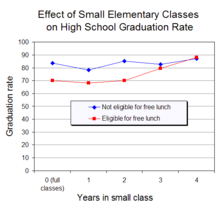
A class size experiment in the United States found that attending small classes for 3 or more years in the early grades increased high school graduation rates of students from low income families.[39]
Main article: Educational theory
Purpose of schools[edit]
Individual purposes for pursuing education can vary. Understanding the goals and means of educational socialization processes may also differ according to the sociological paradigm used.The early years of schooling generally focus around developing basic interpersonal communication and literacy skills. This lays a foundation for more complex skills and subjects. Later, education usually turns toward gaining the knowledge and skills needed to create value and establish a livelihood.[40]
People also pursue education for its own sake to satisfy innate curiosity, out of interest in a specific subject or skill, or for overall personal development.[41]
Education is often understood as a means of overcoming handicaps, achieving greater equality, and acquiring wealth and status for all (Sargent 1994). Education is also often perceived as a place where children can develop according to their unique needs and potentials,[42] with the purpose of developing every individual to their full potential.
Educational psychology[edit]
Main article: Educational psychology
Educational psychology is the study of how humans learn in educational settings, the effectiveness of educational interventions, the psychology of teaching, and the social psychology of schools as organizations. Although the terms "educational psychology" and "school psychology" are often used interchangeably, researchers and theorists are likely to be identified as educational psychologists, whereas practitioners in schools or school-related settings are identified as school psychologists. Educational psychology is concerned with the processes of educational attainment in the general population and in sub-populations such as gifted children and those with specific disabilities.Educational psychology can in part be understood through its relationship with other disciplines. It is informed primarily by psychology, bearing a relationship to that discipline analogous to the relationship between medicine and biology. Educational psychology in turn informs a wide range of specialties within educational studies, including instructional design, educational technology, curriculum development, organizational learning, special education and classroom management. Educational psychology both draws from and contributes to cognitive science and the learning sciences. In universities, departments of educational psychology are usually housed within faculties of education, possibly accounting for the lack of representation of educational psychology content in introductory psychology textbooks (Lucas, Blazek, & Raley, 2006).
The intelligence–education relationship[edit]
Main article: Psychology of education
Intelligence is an important factor in how the individual responds to education. Those who have a genetic advantage of being more intelligent than others tend to perform better at school and go on to higher levels of education.[43] This effect is also observable in the opposite direction, in that education increases measurable intelligence.[44] Studies have shown that while educational attainment is important in predicting intelligence in later life, intelligence at 8 years old is more predictive of intelligence at 53, than measures of educational attainment.[45] Furthermore, it is likely that this trend arises due to genetic factors. As twin studies have shown, inherited traits are more important in predicting educational attainment than any environmental measures.[46] Also, educational attainment and intelligence share more than one half of their genetic influences, suggesting the two are highly related.Learning modalities[edit]
There has been much interest in learning modalities and styles over the last two decades. The most commonly employed learning modalities are:[47]- Visual: learning based on observation and seeing what is being learned.
- Auditory: learning based on listening to instructions/information.
- Kinesthetic: learning based on movement, e.g. hands-on work and engaging in activities.
Dunn and Dunn[48] focused on identifying relevant stimuli that may influence learning and manipulating the school environment, at about the same time as Joseph Renzulli[49] recommended varying teaching strategies. Howard Gardner[50] identified a wide range of modalities in his Multiple Intelligences theories. The Myers-Briggs Type Indicator and Keirsey Temperament Sorter, based on the works of Jung,[51] focus on understanding how people's personality affects the way they interact personally, and how this affects the way individuals respond to each other within the learning environment. The work of David Kolb and Anthony Gregorc's Type Delineator[52] follows a similar but more simplified approach.
Some theories propose that all individuals benefit from a variety of learning modalities, while others suggest that individuals may have preferred learning styles, learning more easily through visual or kinesthetic experiences.[53] A consequence of the latter theory is that effective teaching should present a variety of teaching methods which cover all three learning modalities so that different students have equal opportunities to learn in a way that is effective for them.[54] Guy Claxton has questioned the extent that learning styles such as Visual, Auditory and Kinesthetic(VAK) are helpful, particularly as they can have a tendency to label children and therefore restrict learning.[55][56] Recent research has argued "there is no adequate evidence base to justify incorporating learning styles assessments into general educational practice."[57]
Philosophy[edit]

John Locke's work Some Thoughts Concerning Education was written in 1693 and still reflects traditional education priorities in the Western world.
Main article: Philosophy of education
As an academic field, philosophy of education is "the philosophical study of education and its problems (...) its central subject matter is education, and its methods are those of philosophy".[58] "The philosophy of education may be either the philosophy of the process of education or the philosophy of the discipline of education. That is, it may be part of the discipline in the sense of being concerned with the aims, forms, methods, or results of the process of educating or being educated; or it may be metadisciplinary in the sense of being concerned with the concepts, aims, and methods of the discipline."[59] As such, it is both part of the field of education and a field of applied philosophy, drawing from fields of metaphysics, epistemology, axiology and the philosophical approaches (speculative, prescriptive, and/or analytic) to address questions in and about pedagogy, education policy, and curriculum, as well as the process of learning, to name a few.[60] For example, it might study what constitutes upbringing and education, the values and norms revealed through upbringing and educational practices, the limits and legitimization of education as an academic discipline, and the relation between education theory and practice.Curriculum[edit]
In formal education, a curriculum is the set of courses and their content offered at a school or university. As an idea, curriculum stems from the Latin word for race course, referring to the course of deeds and experiences through which children grow to become mature adults. A curriculum is prescriptive, and is based on a more general syllabus which merely specifies what topics must be understood and to what level to achieve a particular grade or standard.An academic discipline is a branch of knowledge which is formally taught, either at the university–or via some other such method. Each discipline usually has several sub-disciplines or branches, and distinguishing lines are often both arbitrary and ambiguous. Examples of broad areas of academic disciplines include the natural sciences, mathematics, computer science, social sciences, humanities and applied sciences.[61]
Educational institutions may incorporate fine arts as part of K-12 grade curricula or within majors at colleges and universities as electives. The various types of fine arts are music, dance, and theater.[62]
Instruction[edit]
Instruction is the facilitation of another's learning. Instructors in primary and secondary institutions are often called teachers, and they direct the education of students and might draw on many subjects like reading, writing, mathematics, science and history. Instructors in post-secondary institutions might be called teachers, instructors, or professors, depending on the type of institution; and they primarily teach only their specific discipline. Studies from the United States suggest that the quality of teachers is the single most important factor affecting student performance, and that countries which score highly on international tests have multiple policies in place to ensure that the teachers they employ are as effective as possible.[63][64] With the passing of NCLB in the United States (No Child Left Behind), teachers must be highly qualified. A popular way to gauge teaching performance is to use student evaluations of teachers (SETS), but these evaluations have been criticized for being counterproductive to learning and inaccurate due to student bias.[65]Economics of education[edit]
Main article: Economics of education
At the level of the individual, there is a large literature, generally related to the work of Jacob Mincer,[69] on how earnings are related to the schooling and other human capital. This work has motivated a large number of studies, but is also controversial. The chief controversies revolve around how to interpret the impact of schooling.[70][71] Some students who have indicated a high potential for learning, by testing with a high intelligence quotient, may not achieve their full academic potential, due to financial difficulties.[citation needed]
Economists Samuel Bowles and Herbert Gintis argued in 1976 that there was a fundamental conflict in American schooling between the egalitarian goal of democratic participation and the inequalities implied by the continued profitability of capitalist production.[72]
See also[edit]
- Education for Sustainable Development
- Educational technology
- Glossary of education terms
- Human rights education
- Index of education articles
- Mind uploading
- Outline of education
- Progressive education
- Sociology of education
- Unschooling
References[edit]
- Jump up ^ Dewey, John (1944) [1916]. Democracy and Education. The Free Press. pp. 1–4. ISBN 0-684-83631-9.
- Jump up ^ ICESCR, Article 13.1
- Jump up ^ educate. Etymonline.com. Retrieved on 2011-10-21.
- Jump up ^ Assmann, Jan (2002). The Mind of Egypt: History and Meaning in the Time of the Pharaohs. p. 127.
- Jump up ^ "Plato". Encyclopaedia Britannica. 2002.
- ^ Jump up to: a b Geoffrey Blainey; A Very Short History of the World; Penguin Books, 2004
- Jump up ^ "Robert Grosseteste". Catholic Encyclopedia. Newadvent.org. 1 June 1910. Retrieved 2011-07-16.
- Jump up ^ "St. Albertus Magnus". Catholic Encyclopedia. Newadvent.org. 1 March 1907. Retrieved 2011-07-16.
- Jump up ^ Robinson, K.: Schools Kill Creativity. TED Talks, 2006, Monterrey, CA, USA.
- Jump up ^ "Enhancing Education".
- Jump up ^ "Perspectives Competence Centre, Lifeling Learning Programme".
- Jump up ^ Ross, Elizabeth Dale (1976). The Kindergarten Crusade: The Establishment of Preschool in the United States. Athens: Ohio University Press. p. 1.
- Jump up ^ UNESCO, Education For All Monitoring Report 2008, Net Enrollment Rate in primary education
- Jump up ^ "Liberal Arts: Britannica Concise Encyclopædia". Encyclopædia Britannica.
- Jump up ^ Harriman, Philip (1935). "Antecedents of the Liberal Arts College". The Journal of Higher Education 6 (2): 63–71. doi:10.2307/1975506. JSTOR 1975506.
- Jump up ^ Redden, Elizabeth (2009-04-06). "A Global Liberal Arts Alliance". Inside Higher Ed. Retrieved 2015-01-08.
- Jump up ^ Special Education. Oxford: Elsevier Science and Technology. 2004.
- Jump up ^ May, S. and Aikman, S. (2003). "Indigenous Education: Addressing Current Issues and Developments". Comparative Education 39 (2): 139–145. doi:10.1080/03050060302549. JSTOR 3099875.
- Jump up ^ Mead, GH (1896). "The Relation of Play to Education". University Record 1: 141–145.
- Jump up ^ Johnson, GE (1916). "Education through recreation". Cleveland Foundation, Ohio.
- Jump up ^ Jacks, LP (1932). Education through recreation. New York: Harper and Brothers. pp. 1–2.
- ^ Jump up to: a b Ullah, Sha; Bodrogi, Andrew; Cristea, Octav; Johnson, Marjorie; McAlister, Vivian C. (2012). "Learning surgically oriented anatomy in a student-run extracurricular club: an education through recreation initiative". Anat Sci Educ 5 (3): 165–170. doi:10.1002/ase.1273. PMID 22434649.
- Jump up ^ "The State of Digital Education Infographic - #edtech #edutech #edu11". Knewton.com. Retrieved 2012-10-24.
- Jump up ^ Lohr, Steve (19 August 2009). "Study Finds That Online Education Beats the Classroom — NYTimes.com". The New York Times. Retrieved 2012-10-24.
- Jump up ^ Parry, M. (2010). Such a deal? maybe not. online learning can cost more than traditional education. The Chronicle of Higher Education, 57(11)
- Jump up ^ "Free courses provided by Harvard, MIT, Berkeley, Stanford, Princeton, Duke, Johns Hopkins, Edinburgh, U.Penn, U. Michigan, U. Virginia, U. Washington". Neurobonkers.com. 2 August 2012. Retrieved 2012-10-24.
- Jump up ^ Harriet Swain (1 October 2012). "Will university campuses soon be 'over'? | Education". The Guardian (London). Retrieved 2012-10-24.
- Jump up ^ "Is the Certificate the New College Degree? | Jobs on GOOD". Good.is. 8 June 2012. Retrieved 2012-10-24.
- Jump up ^ Cloete, ElsabeÂ. "Electronic Education System Model." Department of Computer Science and Information Systems in South Africa, 17 Oct. 2000. Web. 3 June 2015.
- ^ Jump up to: a b Liesbet Steer and Geraldine Baudienville 2010. What drives donor financing of basic education? London: Overseas Development Institute.
- Jump up ^ news room/latest news/press_releases/2010/2010_02_23_AEW_launch_en. Transparency.org (23 February 2010). Retrieved on 2011-10-21.
- Jump up ^ de Grauwe, A. 2009. Without capacity, there is no development. Paris: UNESCO-IIPE [1].
- Jump up ^ "Socrates-Erasmus Program". Erasmus.ac.uk. Retrieved 2010-06-19.
- Jump up ^ "Soros Foundation". Soros.org. Retrieved 2010-06-19.
- Jump up ^ "African nations embrace e-learning, says new report". PC Advisor. 16 October 2012. Retrieved 2012-10-24.
- Jump up ^ "nabuur.com". nabuur.com. Retrieved 2013-10-03.
- Jump up ^ "EDUSAT". ISRO. Retrieved 2013-01-01.
- ^ Jump up to: a b c "Low-cost private schools: evidence, approaches and emerging issues". Eldis. Retrieved 10 January 2014.
- Jump up ^ Finn, J. D., Gerber, S. B., Boyd-Zaharias, J. (2005). "Small classes in the early grades, academic achievement, and graduating from high school" (PDF). Journal of Educational Psychology 97 (2): 214–233. doi:10.1037/0022-0663.97.2.214.
- Jump up ^ "OOChart:Education and income: More education is key to higher earnings" (PDF). Occupational Outlook Quarterly. Bureau of Labor Statistics. Retrieved 10 January 2014.
- Jump up ^ "Reed College | Reed College Admission Office". Reed.edu. Retrieved 2012-10-24.
- Jump up ^ Schofield, K. (1999). The Purposes of Education, Queensland State Education
- Jump up ^ Butler, S., Marsh, H., & Sheppard, J. (1985). Seven year longitudinal study of the early prediction of reading achievement. Journal of Educational Psychology, 77, 349-361.
- Jump up ^ Baltes, P., & Reinert, G. (1969). Cohort effects in cognitive development in children as revealed by cross sectional sequences. Developmental Psychology, 1, 169-177
- Jump up ^ Richards, M., Sacker, A. (2003) Lifetime Antecedents of Cognitive Reserve. Journal of Clinical and Experimental Neuropsychology, 25, 614-624
- Jump up ^ Johnson, W., McGue, M., Iacono, W. (2006). Genetic and environmental influences on academic achievement trajectories during adolescence. Developmental Psychology, 42, 514-532.
- Jump up ^ Swassing, R. H., Barbe, W. B., & Milone, M. N. (1979). The Swassing-Barbe Modality Index: Zaner-Bloser Modality Kit. Columbus, OH: Zaner-Bloser.
- Jump up ^ "Dunn and Dunn". Learningstyles.net. Retrieved 2009-04-20.
- Jump up ^ "Biographer of Renzulli". Indiana.edu. Retrieved 2009-04-20.
- Jump up ^ Thomas Armstrong's website detailing Multiple Intelligences
- Jump up ^ "Keirsey web-site". Keirsey.com. Retrieved 2009-04-20.
- Jump up ^ "Type Delineator description". Algonquincollege.com. Retrieved 2009-04-20.
- Jump up ^ Barbe, W. B., & Swassing, R. H., with M. N. Milone. (1979). Teaching through modality strengths: Concepts and practices. Columbus, OH: Zaner-Bloser
- Jump up ^ "Learning modality description from the Learning Curve website". Library.thinkquest.org. Retrieved 2010-06-19.
- Jump up ^ "Guy Claxton speaking on What's The Point of School?". dystalk.com. Retrieved 2009-04-23.
- Jump up ^ J. Scott Armstrong (1983). "Learner Responsibility in Management Education, or Ventures into Forbidden Research (with Comments)" (PDF). Interfaces 13.
- Jump up ^ Pashler, Harold; McDonald, Mark; Rohrer, Doug; Bjork, Robert (2009). "Learning Styles: Concepts and Evidence" (PDF). Psychological Science in the Public Interest 9 (3): 105–119. doi:10.1111/j.1539-6053.2009.01038.x.
- Jump up ^ Noddings, Nel (1995). Philosophy of Education. Boulder, CO: Westview Press. p. 1. ISBN 0-8133-8429-X.
- Jump up ^ Frankena, William K.; Raybeck, Nathan; Burbules, Nicholas (2002). "Philosophy of Education". In Guthrie, James W. Encyclopedia of Education, 2nd edition. New York, NY: Macmillan Reference. ISBN 0-02-865594-X.
- Jump up ^ Noddings 1995, pp. 1–6
- Jump up ^ "Examples of subjects". Curriculumonline.gov.uk. Retrieved 2009-04-20.
- Jump up ^ "Fine Arts". Education World. 2011-02-24. Retrieved 2013-10-03.
- Jump up ^ Winters, Marcus. Teachers Matter: Rethinking How Public Schools Identify, Reward, and Retain Great Educators. Rowman & Littlefield. p. 160. ISBN 978-1-4422-1077-6.
- Jump up ^ How the world's best-performing school systems come out on top. mckinsey.com. September 2007
- Jump up ^ J. Scott Armstrong (2012). "Natural Learning in Higher Education". Encyclopedia of the Sciences of Learning.
- Jump up ^ Eric A. Hanushek (2005). Economic outcomes and school quality. International Institute for Educational Planning. ISBN 978-92-803-1279-9. Retrieved 21 October 2011.
- Jump up ^ Daron Acemoglu, Simon Johnson, and James A. Robinson (2001). "The Colonial Origins of Comparative Development: An Empirical Investigation". American Economic Review 91 (5): 1369–1401. doi:10.2139/ssrn.244582. JSTOR 2677930.
- Jump up ^ Eric A. Hanushek and Ludger Woessmann (2008). "The role of cognitive skills in economic development" (PDF). Journal of Economic Literature 46 (3): 607–608. doi:10.1257/jel.46.3.607.
- Jump up ^ Jacob Mincer (1970). "The distribution of labor incomes: a survey with special reference to the human capital approach". Journal of Economic Literature 8 (1): 1–26. JSTOR 2720384.
- Jump up ^ David Card, "Causal effect of education on earnings," in Handbook of labor economics, Orley Ashenfelter and David Card (Eds). Amsterdam: North-Holland, 1999: pp. 1801–1863
- Jump up ^ James J. Heckman, Lance J. Lochner, and Petra E. Todd., "Earnings functions, rates of return and treatment effects: The Mincer equation and beyond," in Handbook of the Economics of Education, Eric A. Hanushek and Finis Welch (Eds). Amsterdam: North Holland, 2006: pp. 307–458.
- Jump up ^ Samuel Bowles; Herbert Gintis (18 October 2011). Schooling In Capitalist America: Educational Reform and the Contradictions of Economic Life. Haymarket Books. ISBN 978-1-60846-131-8. Retrieved 21 October 2011.
External links[edit]
| Definitions from Wiktionary | |
| Media from Commons | |
| News stories from Wikinews | |
| Quotations from Wikiquote | |
| Source texts from Wikisource | |
| Textbooks from Wikibooks | |
| Learning resources from Wikiversity | |
| Library resources about Education |
- Education at DMOZ
- Educational Resources from UCB Libraries GovPubs
- UNESCO Institute for Statistics: International comparable statistics on education systems
- OECD Education GPS: Statistics and policy analysis, interactive portal
- OECD Statistics
- Planipolis: a portal on education plans and policies
- IIEP Publications on Education Systems
| ||||||||||||||||||||||||||||||||||||
| ||
| ||








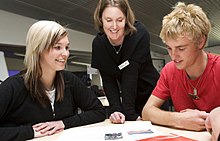




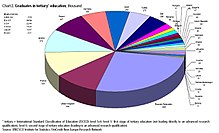

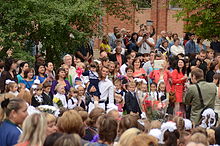
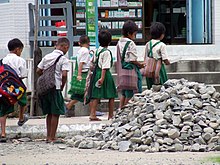
No comments:
Post a Comment